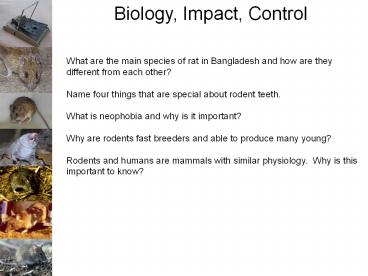rats - PowerPoint PPT Presentation
1 / 31
Title: rats
1
Biology, Impact, Control
What are the main species of rat in Bangladesh
and how are they different from each other? Name
four things that are special about rodent
teeth. What is neophobia and why is it
important? Why are rodents fast breeders and
able to produce many young? Rodents and humans
are mammals with similar physiology. Why is this
important to know?
2
Biology, Impact, Control
Name 10 reasons why it is important to control
rats. Name 3 reasons why rodents are important
vectors and reservoirs of human diseases. Name 2
rat-borne diseases that are present in
Bangladesh. What are the 3 things that rodents
need to survive?
3
Biology, Impact, Control
Name 4 things that you can look for to indicate
the presence of rodents. Why are chronic poisons
better than acute poisons? Why might a farmer
choose to use acute poisons instead of chronic
poisons? Why are predators a poor rat control
technique? Why is environmental management
important when trying to control rat
populations? What are the five steps to follow
for rat management?
4
Ecologically-Based Rodent Management
5
Applied EBRM action
6
Ecologically-Based Rodent Management
- Rodent biology
Species behaviour, breeding rates, habitat
utilisation, population dynamics
Damage
Holistic assessment damage to agriculture,
health, personal possessions and property
7
Ecologically-Based Rodent Management
- Knowledge, Attitudes and Practice
Peoples need to see dead bodies leads to use of
acute poisons that are dangerous and ineffective
in reducing rodent populations
Treatment failure leads to apathy and acceptance
of rodent pests e.g. rodents are too clever to
be controlled
8
Ecologically-Based Rodent Management
- Community-led strategy
Technology effective, easy to use and durable
Population reduction at the appropriate scale
and time through trapping, anticoagulants,
hunting, bounties
Environmental management permanently reduce the
carrying capacity through reducing access to
harbourage, food and water, hygiene sanitation,
habitat modification
9
Rodent Managers
Qualified personnel service providers Pest
Control Operators Environmental Health
Officers Agriculture Extensionists
- Everyone else rural / urban settlements
- Farmers
- Households
- Communities
10
Understanding the Manager
11
(No Transcript)
12
(No Transcript)
13
(No Transcript)
14
(No Transcript)
15
(No Transcript)
16
(No Transcript)
17
Tools that we can use to understand the Rodent
Manager
- Knowledge, Attitude and Practice Survey
- Community meetings
18
(No Transcript)
19
Tools that we can use to understand the Rodent
Manager
- Knowledge, Attitude and Practice Survey
- Community meetings
- Resource mapping / survey
20
(No Transcript)
21
Tools that we can use to understand the Rodent
Manager
- Knowledge, Attitude and Practice Survey
- Community meetings
- Resource mapping / survey
- Individual meetings / questionnaires
22
(No Transcript)
23
Tools that we can use to understand the Rodent
Manager
- Knowledge, Attitude and Practice Survey
- Community meetings
- Resource mapping / survey
- Individual meetings / questionnaires
- Observation
24
(No Transcript)
25
Designing your KAP survey
- Culture
- Gender
- Education
- Language
- Experimental variables
Consultation Pre-testing Experience
26
(No Transcript)
27
(No Transcript)
28
(No Transcript)
29
Are there generalisations we can make about
Rodent Managers?
- People like to see dead bodies
- Poison should act fast acute/chronic
predicament - Underestimation of the damage caused
- Limited microbiological rodent ecology
knowledge - Anthropomorphism
- Trap shy dogma
- The technology gap
cant ask for
unknown technology
30
Ecologically-based rodent management
Needs to be based on sound ecological and
sociological data
Must take account of local biological and
socio-economic constraints
Works best at the community level with a minimum
number of freeloaders (social cohesion)
Must convince Rodent Managers that their lives
have significantly improved (economically,
health, food security)
31
EBRM Conclusions
People underestimate the impact of rodents on
their livelihoods
Traditional rodent management practice has little
impact on rodent numbers or damage caused
Rodent pests can be successfully managed by
communities armed with the right knowledge and
tools
Communities see results after implementing EBRM
and rate it as economically and environmentally
sustainable

